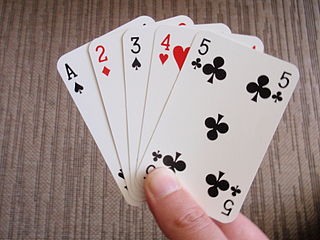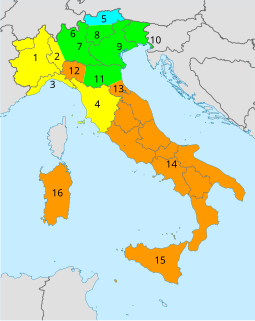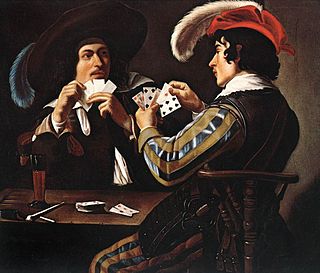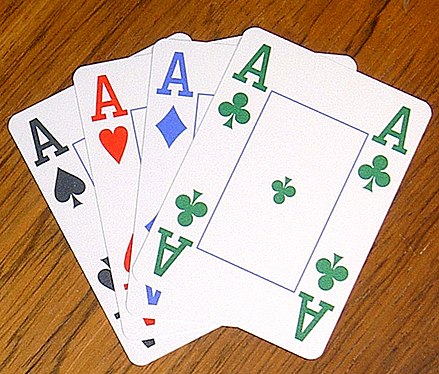
A stripped deck (US) or shortened pack (UK) is a set of playing cards from which some cards have been removed. The removed cards are usually the pip cards. Many card games use stripped decks, and stripped decks for popular games are commercially available.

The tarot is a pack of playing cards, used from the mid-15th century in various parts of Europe to play games such as Italian tarocchini, French tarot and Austrian Königrufen. Many of these tarot card games are still played today. In the late 18th century, some Tarot packs began to be used in parallel for divination in the form of tarotology and cartomancy and, later, specialist packs were developed for such occult purposes.
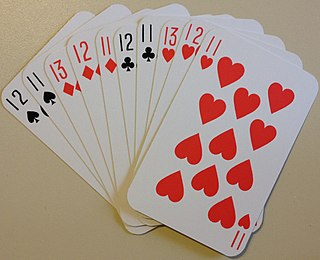
500 or five hundred, also called bid Euchre is a trick-taking game that is an extension of euchre with some ideas from bridge. For two to six players, it is most commonly played by four players in partnerships, but is sometimes recommended as a good three-player game. It arose in America before 1900 and was promoted by the United States Playing Card Company, which copyrighted and marketed the rules in 1904. 500 is a social card game and was highly popular in the United States until around 1920 when first auction bridge and then contract bridge drove it from favour. 500 continues to enjoy popularity in Ohio and Pennsylvania, where it has been taught through six generations community-wide, and in other countries: Australia, New Zealand, Quebec and Shetland. The Originator of Five Hundred, US Playing Card Company of Cincinnati, Ohio, now headquarters across the Ohio River in Erlanger, Kentucky, west of Covington, KY. Five hundred is now the national game of Australia.

An ace is a playing card, die or domino with a single pip. In the standard French deck, an ace has a single suit symbol located in the middle of the card, sometimes large and decorated, especially in the case of the ace of spades. This embellishment on the ace of spades started when King James VI of Scotland and I of England required an insignia of the printing house to be printed on the ace of spades. This insignia was necessary for identifying the printing house and stamping it as having paid the new stamp tax. Although this requirement was abolished in 1960, the tradition has been kept by many card makers. In other countries the stamp and embellishments are usually found on ace cards; clubs in France, diamonds in Russia, and hearts in Genoa because they have the most blank space.
The Joker is a playing card found in most modern card decks, as an addition to the standard four suits. The Joker originated in the United States during the Civil War and was created as a trump card for the game of Euchre. It has since been adopted into many other card games, where it may function as a wild card. The card is unique within the French pack in that it lacks an industry-wide standard appearance.

The deck of French playing cards is the most common deck of playing cards used today. It includes thirteen ranks in each of the four French suits: clubs, diamonds, hearts and spades, with reversible "court" or face cards. Each suit includes an ace, a king, queen and jack, each depicted with a symbol of its suit; and ranks two through ten, with each card depicting that many symbols (pips) of its suit. Anywhere from one to six jokers, often distinguishable with one being more colorful than the other, are added to commercial decks, as some card games require these extra cards. Modern playing cards carry index labels on opposite corners or in all four corners to facilitate identifying the cards when they overlap and so that they appear identical for players on opposite sides. The most popular standard pattern of the French deck is sometimes referred to as "English" or "Anglo-American" pattern.
High card by suit and low card by suit refer to assigning relative values to playing cards of equal rank based on their suit. No standard ranking of suits exists for card games and not all games incorporate a suit ranking feature. When suit ranking is applied, the two most common conventions are:
A four-color deck is identical to the standard French deck except for the color of the suits. In a typical English four-color deck, hearts are red and spades are black as usual, but clubs are green and diamonds are blue. However, other color combinations have been used over the centuries, in other areas or for certain games.

Sheng ji is a family of point-based, trick-taking card games played in China and in Chinese immigrant communities. They have a dynamic trump, i.e., which cards are trump changes every round. As these games are played over a wide area with no standardization, rules vary widely from region to region.

Cego or Baden Tarock, also called Ceco, is a tarot card game played mainly in Baden, the Black Forest, the adjacent Baar lowland and around Lake Constance in Switzerland and Austria. The game is similar to Königrufen and Tapp-Tarock. It is distinguished by a large skat, or talon, called "the Blind".
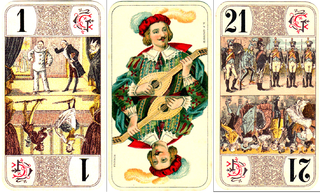
The Tarot Nouveau, French Tarot Nouveau or Bourgeois Tarot deck is a pattern of tarot cards. As such it differs from those tarot decks used in fortune-telling, such as the Tarot of Marseilles and Rider-Waite decks, in that the Tarot Nouveau is designed solely for playing the various tarot card games for which the 78-card tarot deck was originally devised, such as the game of French Tarot. In the French language, this deck is often called the tarot à jouer or playing tarot. This usage is distinct from cartomancy and other divinatory purposes, for which the tarot is most commonly known outside Continental Europe. This deck is most commonly found in France, Wallonia, Romandy, Québec, and Denmark.
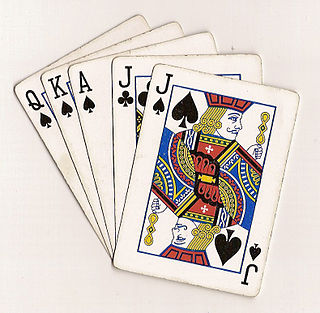
This article deals with variations in game playing. For a description on variations in game rules and terminology, see Euchre variations.

The following is a glossary of terms used in card games. Besides the terms listed here, there are thousands of common and uncommon slang terms. This list does not encompass terms that are specific to one game.

French playing cards are cards that use the French suits of trèfles, carreaux, cœurs, and piques. Each suit contains three face cards; the valet, the dame, and the roi (king). Aside from these aspects, decks can include a wide variety of regional and national patterns which often have different deck sizes. In comparison to Spanish, Italian, German, and Swiss playing cards, French cards are the most widespread due to the geopolitical, commercial, and cultural influence of France and the United Kingdom in the past two centuries. Other reasons for their popularity were the simplicity of the suit insignia, which simplifies mass production, and the popularity of whist and contract bridge.
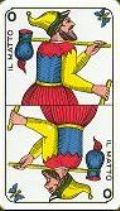
Scarto is a three player trick-taking tarot card game from Piedmont, Italy. It is a simple tarot game which can serve as an introduction to more complex tarot games. The name comes from the discarded cards that were exchanged with the stock, which is also the origin of the name for the Skat card game.

